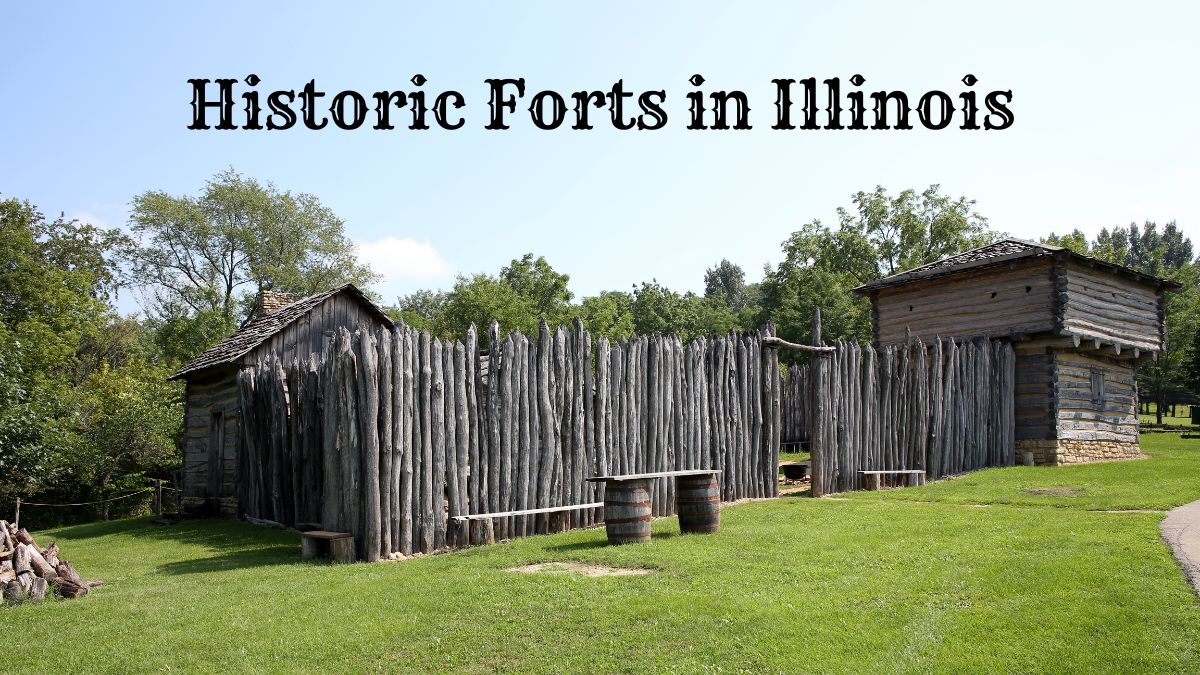Illinois boasts a rich tapestry of history, woven with the threads of explorations, wars, and settlements. Nestled within its terrain are several historic forts withstood the test of time, each holding tales of the bygone era.
From the picturesque banks of the Mississippi River to the thriving settlements of Prairie du Rocher, here’s a journey through some of the most significant fortifications in the Land of Lincoln.
In this article, historic forts in Illinois, we will explore nine forts that shaped this part of the United States.
Historic Forts in Illinois
| 1. Fort de Chartres | 6. Fort Massac |
| 2. Fort Kaskaskia | 7. Fort Crevecoeur |
| 3. Apple River Fort | 8. Fort Edwards |
| 4. Fort Armstrong | 9. Fort St. Louis du Rocher |
| 5. Fort Dearborn |
1. Fort de Chartres: The French Bastion in Illinois Country
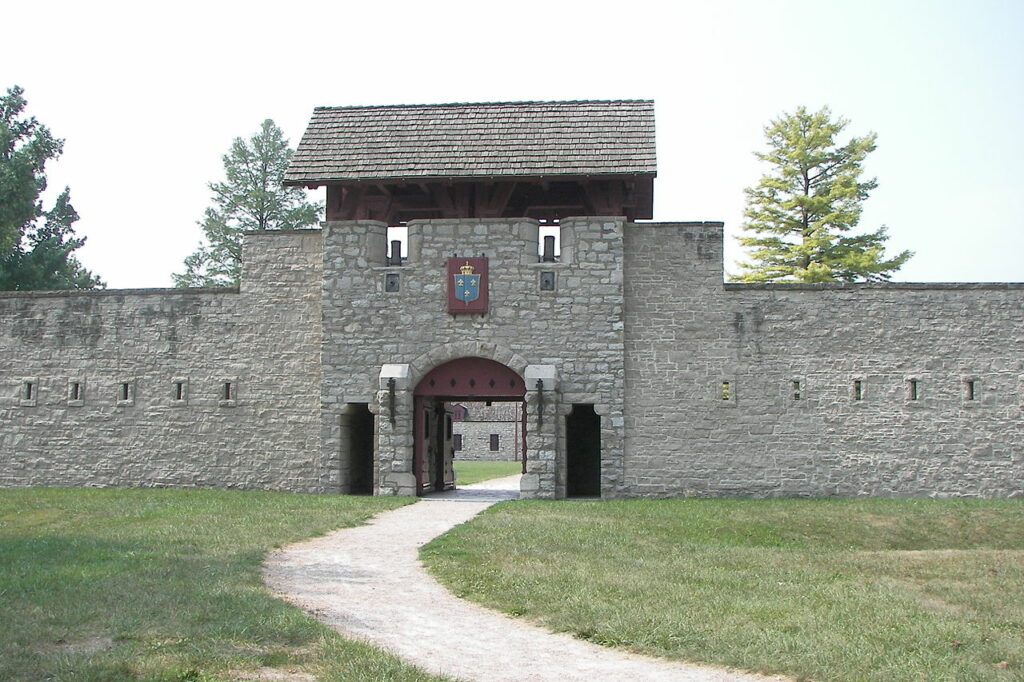
Nestled near the serene backdrop of Prairie du Rocher lies one of the most historically significant landmarks in Illinois: Fort de Chartres.
The fort, with its legacy deeply intertwined with the narrative of the French regime in North America, showcases a vivid representation of early colonial life and the power dynamics of the time.
The name “Fort de Chartres” was a tribute to Louis, duc de Chartres, the son of the Regent of France.
Its establishment was not an isolated incident; instead, it was part of a broader French strategy to fortify their claims in the Mississippi Valley against encroachments, particularly from Great Britain.
Initially founded in the 1720s, the first two forts on the site were of wooden construction and succumbed to the elements, notably the Mississippi River’s flooding.
It wasn’t until the 1750s that the third and most impressive fort, the one whose remnants we see today, was constructed. Made predominantly of limestone, this fort stood as the epitome of the French military architectural style of the 18th century.
Significance in Governance
During its peak, Fort de Chartres wasn’t merely a military post. It served as the administrative center and the French seat of government for the entire Illinois Country, a vast region extending between the Great Lakes and the Mississippi River.
Given its strategic location, it facilitated trade, diplomacy, and military operations for the French crown.
Key Personalities
While many played a role in the fort’s story, two figures stand out:
- Pierre Dugue de Boisbriand: The man responsible for establishing the first Fort de Chartres in 1720. His vision and tenacity laid the foundation for a major regional establishment.
- Commandant Jean St. Ange: St. Ange was the last French commander of the fort. Following the Treaty of Paris in 1763, where France ceded its territories east of the Mississippi River to Great Britain after the Seven Years’ War, he played a crucial role in the transition of control.
Architectural Marvels and Remnants
Apart from its military and administrative function, the fort was an architectural marvel of its time. The powder magazine, the oldest building in Illinois, is a testament to the fort’s durability and the craftsmanship of its builders. The Catholic chapel reflects the spiritual life of its inhabitants and the role of religion in the everyday lives of the soldiers and settlers.
Several rooms, including the gunner’s room, day room, and guard’s room, have been preserved, showcasing the living and operational conditions of the time. Moreover, inscriptions on its walls detail its original foundations, providing visitors with a direct link to the past.
Today’s Experience
Today, Fort de Chartres is a beacon of history, recognized as a National Historic Landmark.
While the fort offers an immersive journey into the past, its surroundings, equipped with picnic tables and a dedicated parking lot, ensure a comfortable visit for families and history enthusiasts alike.
2. Fort Kaskaskia: A Glimpse into the Illinois Frontier
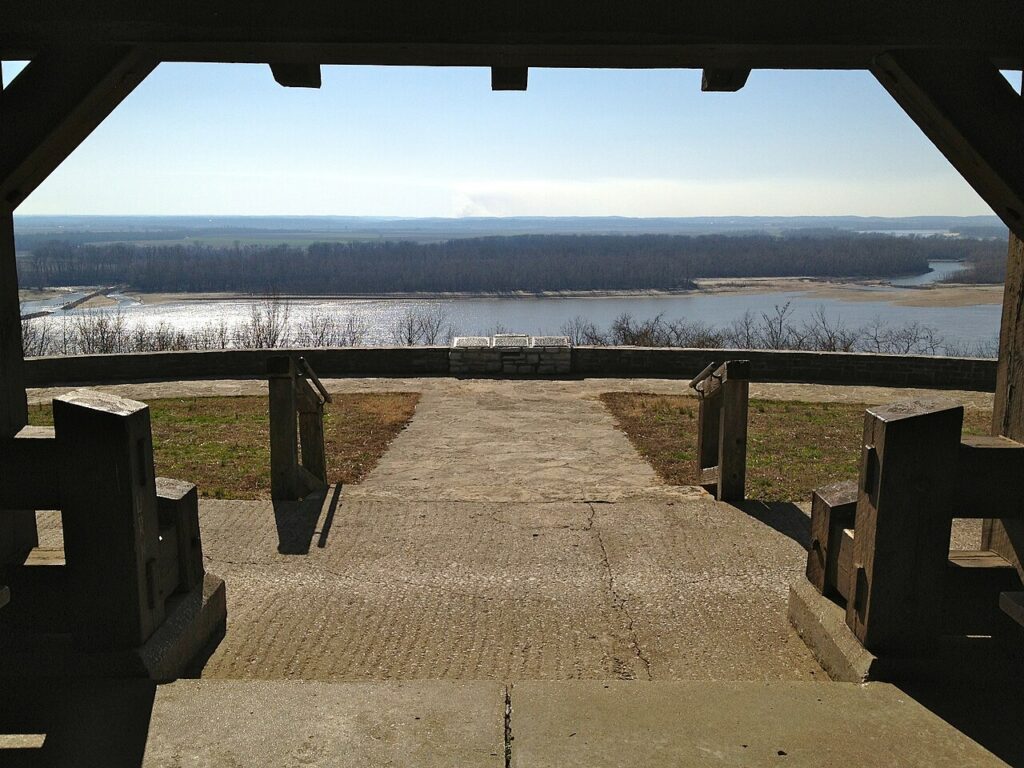
Perched high with a vantage point over the meeting of the Mississippi and Kaskaskia rivers, the Fort Kaskaskia State Historic Site captivates those who are passionate about history and the tales of yesteryears.
While today’s visitors are treated to picturesque views, the significance of Fort Kaskaskia goes beyond its natural beauty. The fort played an essential role in the early days of the Illinois frontier.
Being strategically located, it served as a vital point for defense, trade, and communication during its operational years.
Kaskaskia is derived from the name of a local Native American tribe. The region was important long before European settlers arrived, with indigenous peoples valuing its fertile land and strategic location.
When the French and later the British and Americans settled in the area, the significance of this spot was recognized, leading to the establishment of the fort.
Key Figures and Events
Over the years, Fort Kaskaskia witnessed the ebbs and flows of power dynamics:
- The French Era: Initially, the French had control over the region, with settlements burgeoning along the Mississippi, fostering trade and relations with local Native American tribes.
- British Control: Following the French and Indian War, the British took control of the region in the Treaty of Paris (1763). However, their tenure was relatively short-lived.
- American Frontier: By the American Revolution, the region became a critical frontier zone. The fort and the surrounding areas, like Kaskaskia village, played a role in the Revolutionary War’s western front. George Rogers Clark, an American military leader, took control of Kaskaskia in 1778, marking a shift in regional dynamics.
Remnants of the Past
While the years have eroded much of the original structure, the fort’s foundation is a silent witness to its rich past.
This foundation, though faint, has been a topic of interest among historians, leading to extensive research and the documentation of its significance in numerous historical documents.
Moreover, the site’s evolution has ensured it remains a place of interest. The picnic shelter, for instance, allows modern visitors to soak in panoramic views of the rivers and the expansive landscapes that stretch beyond.
3. Apple River Fort: The Bastion of Defense in the Black Hawk War
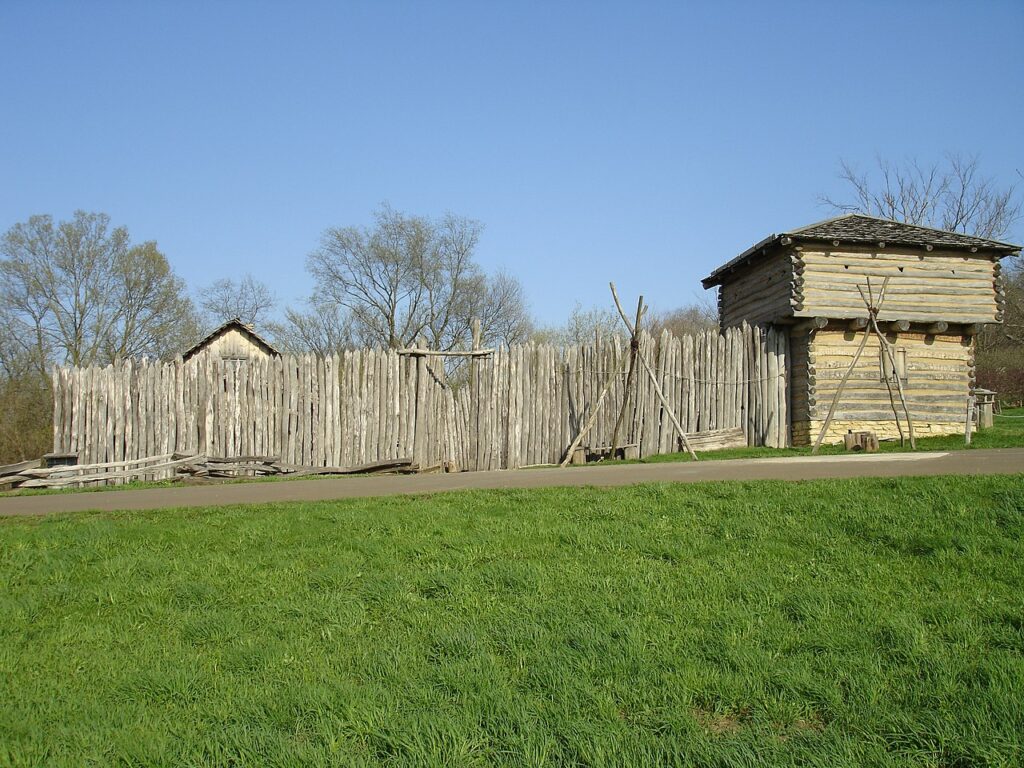
Nestled in the quaint town of Elizabeth, the Apple River Fort emerges as a symbol of resilience, defense, and the tumultuous history of the Midwest during the 19th century.
To truly understand the significance of Apple River Fort, one must delve into the backdrop of the Black Hawk War. This conflict, which took place in 1832, was led by Black Hawk, a Sauk leader.
Discontented with the treaties that forced Native American tribes from their ancestral lands, Black Hawk, alongside a band of Sauk, Meskwaki, and Kickapoo warriors, sought to resettle in their homeland across the Mississippi River.
This led to confrontations with American militia and settlers, triggering the Black Hawk War.
The Fort’s Role
Amidst this volatile setting, Apple River Fort emerged as a haven for white settlers in the region. The wooden structure, though modest in its construction, played an outsized role in the lives of the local community.
On June 24, 1832, the fort became a key battleground.
When Black Hawk and his warriors attacked, the settlers, bolstered by their defenses and the fort’s strategic design, repelled them, preventing a potential massacre. This battle underscored the fort’s critical role in the larger theater of the war.
Architecture and Life Inside
Beyond its military significance, Apple River Fort offers a window into the daily lives of the settlers of that era.
Its wooden palisades, encasing small cabins and a central blockhouse, reflect the pragmatic architectural style of frontier settlements.
Within its walls, the community would have carried out their daily tasks, lived, and socialized, all while under the looming threat of external aggression.
Today’s visitors to the site can embark on self-guided tours, walking through the reconstructed spaces and getting a tangible sense of the conditions, challenges, and realities of military and civilian life during that turbulent period.
Modern Day Preservation
Preservation efforts have ensured that the legacy of Apple River Fort endures.
The reconstructed fort serves as a living museum, educating visitors about the Black Hawk War, the settlers, and the broader dynamics of Native American displacement and frontier life.
Interactive displays, artifacts, and guided narratives immerse guests in a journey back in time.
4. Fort Armstrong: The Heartbeat of Rock Island’s History
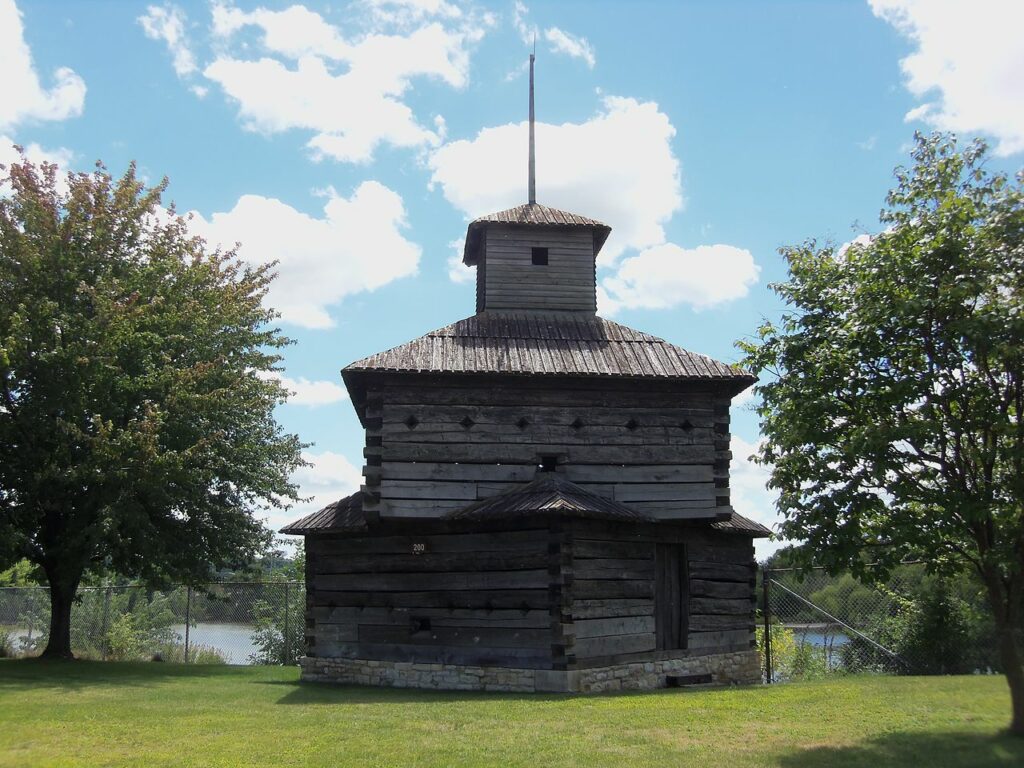
Nestled on the iconic Rock Island in the Mississippi River, Fort Armstrong remains deeply ingrained in the annals of American history. Its role in shaping the nation’s past, from its central position during the Black Hawk War to its ties with legendary explorers, is undeniable.
The birth of Fort Armstrong in 1816 was part of a broader initiative to secure newly won territories after the War of 1812. Its perch on Rock Island ensured dominance over river traffic and served as a bulwark against potential threats.
Central Role in the Black Hawk War
The escalating tensions between Native American tribes and American settlers culminated in the Black Hawk War. Throughout this conflict, Fort Armstrong was the primary military installation.
It not only coordinated military strategies and operations but also offered refuge to settlers during these volatile times.
Lewis and Clark’s Footprints
The adventurous duo, Meriwether Lewis and William Clark, known for their expansive journey across the western reaches of the continent, left an indelible mark on the region surrounding Fort Armstrong.
Though the fort’s establishment came after their famed expedition, the insights and records they provided about the area were foundational in subsequent American endeavors, including military installations like Fort Armstrong.
The Continuing Legacy: Rock Island Arsenal and National Cemetery
While time has transformed the original structures of Fort Armstrong, its enduring spirit can be felt today.
The Rock Island Arsenal, the most giant government-owned weapons manufacturing arsenal in the United States, highlights the continued strategic importance of Rock Island.
Close by, the Rock Island National Cemetery offers a solemn tribute, providing a resting place for veterans and their families. This space underscores the island’s lasting connection to the military and honors the sacrifices made by countless individuals.
5. Fort Dearborn: Chicago’s Bedrock of History
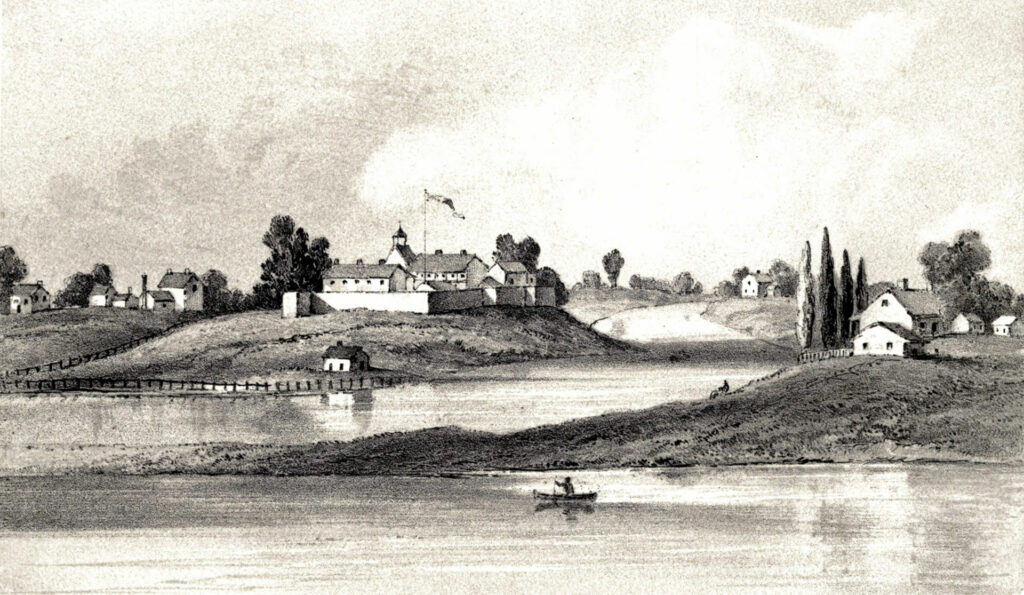
Nestled within the bustling heart of modern-day Chicago, the story of Fort Dearborn intertwines with the very origins of this iconic city.
Its pivotal role during the American Revolution and the subsequent early years of the United States positions it as a cornerstone in the nation’s foundational narrative.
During the tumultuous times of the American Revolution, Fort Dearborn emerged as a focal point of military activity. British troops, keen on maintaining their foothold in the region, established their presence here.
The fort, however, was not just a passive backdrop; it became an active player, witnessing strategic discussions, skirmishes, and the ebb and flow of troops, making it integral to the larger theater of the revolution.
Beyond the Revolution: A Catalyst for Growth
The end of the revolution marked a new beginning for Fort Dearborn. As the United States embarked on its journey as a fledgling nation, the fort took on new significance.
Situated along the major trade routes and waterways, it played a role in the country’s westward expansion, fostering commerce, trade, and settlement.
The presence of the fort catalyzed the growth and development of the region, which would eventually burgeon into the metropolis of Chicago.
Marking the Past: The Historical Marker
Today, amid the urban sprawl and architectural marvels of Chicago, a historical marker stands as a silent witness to the past. This marker demarcates the exact location of Fort Dearborn, offering passersby a glimpse into a time long gone.
It serves as both a tribute and an educational tool, allowing residents and tourists alike to connect with a critical chapter of Chicago’s — and America’s — history.
6. Fort Massac: A Tapestry of Time Along the Ohio River

Lying close to the serene banks of the Ohio River in the town of Metropolis, Fort Massac tells a multi-layered story that spans epochs, cultures, and significant historical events.
Its presence provides an intimate look into the past, from the days of successive French forts to pivotal moments during the American Revolution.
Before it played a role in the American Revolution, Fort Massac had already etched its place in history through its association with the French.
As they ventured into the Illinois territory, the French established a series of forts in the region. Fort Massac, in its earliest incarnation, was one of these strategic outposts.
These forts were central in establishing French influence, fostering trade, and creating diplomatic ties with Native American tribes.
American Revolution and Fort Massac’s Significance
As the winds of the American Revolution swept across the continent, Fort Massac found itself again at the heart of crucial events.
Serving as a linchpin in the broader revolutionary conflict, it witnessed skirmishes, strategy developments, and significant troop movements. Its strategic location along the Ohio River made it a vital asset for the British and the American forces.
Architectural Marvel: The Stone Fortress
Today, Fort Massac stands out not just for its historical significance but also for its architectural prowess.
The massive stone fort, a testament to the engineering and design sensibilities of its era, draws visitors and scholars alike. Its robust walls, bastions, and intricate design make it a symbol of resilience and military might.
Delving Deeper: The Combination Museum
To further enrich the experience for those eager to understand the fort’s storied past, a combination museum has been established within its precincts.
This museum provides a deep dive into the fort’s history, offering artifacts, displays, and narratives that cover its French origins, its role during the American Revolution, and its continued relevance in subsequent years.
7. Fort Crevecoeur: Chronicles of French Exploration in Peoria
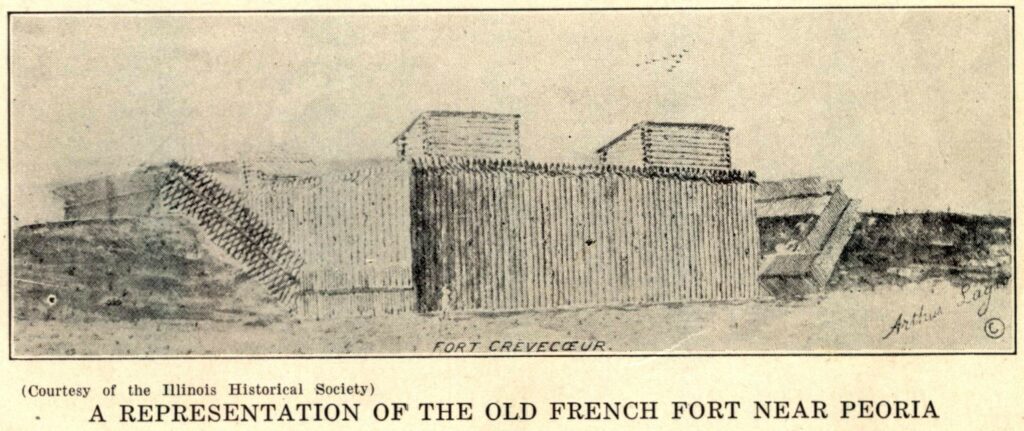
Positioned near the modern-day city of Peoria, Fort Crevecoeur stands as a silent whisper of early French endeavors in the heart of America.
Founded in 1680 by intrepid French explorers, its tale is about ambition, discovery, and the impermanence of human constructs.
As the late 17th century saw European powers jostling for dominance and territories in the New World, France was keen to carve out its niche.
Explorers were dispatched to navigate and lay claim to uncharted lands, driven by dreams of wealth, strategic footholds, and new alliances.
It was during this era of exploration that Fort Crevecoeur was established, marking the presence and ambition of the French in the region.
A Strategic Outpost in the Illinois Territory
Positioned strategically along the Illinois River, Fort Crevecoeur became a vital outpost for the French.
It facilitated trade, fostered relations with Native American tribes, and was a staging ground for further explorations into the vast and varied North American landscape.
During its tenure, the fort bore witness to the intricacies of diplomacy, commerce, and the challenges of frontier life.
The Ephemeral Nature of Early Settlements
While Fort Crevecoeur played a pivotal role in the French’s early American adventures, the sands of time have obscured its physical presence.
The original structure, crafted with the materials and techniques of its time, eventually succumbed to the elements, conflicts, or both. Today, there remains no trace of the fort’s original tower, reminding us of the transient nature of human endeavors.
Legacy Beyond the Structure
Though the original fort no longer graces the landscape, the legacy of Fort Crevecoeur is far from forgotten. Its establishment is a testament to the spirit of exploration and the drive to expand horizons.
The fort’s history has left an indelible mark on the region, influencing subsequent settlements, interactions, and the cultural fabric of present-day Peoria.
8. Fort Edwards: Military Outpost to Trade Hub
Adjacent to the Mississippi River and opposite Alexandria, Mo., Warsaw’s origins hark back to the 19th century. Central to its emergence were two pivotal structures: Fort Johnson and Fort Edwards.
Constructed on the eastern side of the Mississippi, these fortifications were among approximately 94 others dotting Illinois. Their presence was partly a response to a British stronghold around 100 miles north.
Fueling the rise of such fortifications was William Henry Harrison Sr., the would-be 9th U.S. President, who in 1807 decreed that new settlements be fortified.
By 1814, atop a commanding bluff overlooking the Mississippi, Fort Edwards stood tall. Named in honor of Ninian Edwards, the first governor of Illinois, its primary mission was to shield the vital river supply routes.
With soldiers posted nearby, the surrounding region witnessed a surge in inhabitants, including the Sauk and Iowa tribes who cultivated corn.
The fort’s purpose shifted over time. Between 1828 and 1832, the American Fur Company repurposed Fort Edwards into a vibrant fur trading center. Yet, by 1824, all activity ceased, erasing any physical remnants of the fort.
Pioneers and Settlers: The Building of a Community
Major John R. Wilcox, once stationed at Fort Edwards, emerged as a key figure in shaping Warsaw’s destiny.
Following the fort’s abandonment, he constructed a log cabin near the original Fort Johnson site, marking one of Warsaw’s earliest domiciles. His subsequent establishment of a ferry in 1836 provided a vital link between Warsaw and Alexandria.
The city’s early days saw settlers like Mark Aldrich construct foundational structures, with Aldrich’s two-story log home being a notable early addition.
By 1834, with the city’s population hovering around 24, pioneers such as Wilcox, Aldrich, John Montague, and John Vineyard began charting Warsaw’s urban footprint.
Warsaw’s Golden Era: Growth and Diversity
The 1840s signaled a transformative period for Warsaw. Passenger boats teeming with emigrants from countries like Ireland, Germany, and France began to arrive. Recognized as a town in 1839, Warsaw soon achieved city status by 1853.
The city’s economic landscape diversified, with industries spanning from distilleries and flour mills to cooperage shops. The late 1850s ushered in a wave of French immigrants, further enriching Warsaw’s cultural tapestry.
William Grover’s 1871 recollections provide a window into Warsaw’s evolution, spotlighting landmarks and charting its socio-economic trajectory.
Remembering Fort Edwards
Today, while Ralston Park in Warsaw occupies the backdrop of Fort Edwards, a 1914 monument on the original site stands as a solemn tribute. It serves as a lasting reminder of the city’s vibrant history and the indomitable spirit of its early settlers.
9. Fort St. Louis du Rocher: The French Bastion in Illinois Country
Amid the Illinois landscape and by the meandering Illinois River, French pioneers, headed by René-Robert Cavelier, Sieur de La Salle, and Henry de Tonty, founded Fort St. Louis on a prominent butte named Le Rocher during the winter of 1682.
This elevated location gave them a tactical edge over the region. Rather than intricate fortifications, La Salle opted for a simple wooden barrier to safeguard the fort. Within its confines, the fort housed wooden structures and shelters built by the indigenous population.
Aims and Native Alliances
The French envisioned Fort St. Louis as a defense against potential English advances. The goal was to restrict English settlements to the eastern coast.
The French were not alone; they were accompanied by allies from various native tribes that had relocated from the east, such as the Miami, Shawnee, and Mahican. These tribes founded a new community at the butte’s base, now recognized as Hotel Plaza.
After the expiration of La Salle’s exclusive rights over the region, Governor Joseph-Antoine de La Barre designed to claim both Fort St. Louis and Fort Frontenac.
Acting on the governor’s directive, a contingent of traders and an officer made their way to Illinois. By August 11, 1683, they had secured a significant stretch of the northern portage shore.
Challenges and Decline
The Beaver Wars brought tumultuous times. During the French and Indian Wars, Fort St. Louis became a sanctuary against Iroquois offensives, who were in league with the British.
By 1691, under the leadership of Henri de Tonty, the fort’s residents were forced to evacuate due to Iroquois pressures. Not long after, de Tonty regrouped the settlers and established Fort Pimiteoui, now in contemporary Peoria.
French forces, under the command of Pierre Deliette, possibly occupied Fort St. Louis between 1714 and 1718.
However, Deliette’s reign over the region concluded when the territory transitioned from Canadian to Louisiana governance. By the early 18th century, the fort witnessed sporadic use by fur trappers and merchants, but over time, it fell into disrepair.
Legacy
Although Fort St. Louis du Rocher no longer graces the landscape with its physical presence, its historical imprint remains undiminished, serving as a reminder of the French endeavors in the Illinois Country.
Related: 10 Historic Forts in Massachusetts
Conclusion – Historic Forts in Illinois
Illinois, with its strategic location and rich history, has been a melting pot of cultures, conflicts, and collaborations.
The historic forts of Illinois not only offer a glimpse into the tactical and defensive priorities of bygone eras but narrate the story of the state’s evolution from a contested frontier to a thriving part of the nation.
As silent witnesses to countless pivotal moments, these fortifications encapsulate the spirit of resilience, ambition, and exploration that has shaped Illinois.
While many of these forts no longer stand physically, their legacies persist, reminding us of the sacrifices, challenges, and triumphs that have paved the way for the modern state we know today.
Thanks for reading, and if you have visited any of these forts, we would love to hear about your experience in the comments section below.

Cory is a website owner and content creator who enjoys fishing, history, coin collecting, and sports, among other hobbies. He is a husband and father of four.
Romans 15:4 For whatever was written in former days was written for our instruction, that through endurance and through the encouragement of the Scriptures we might have hope.

